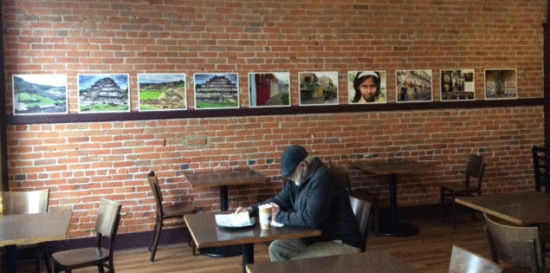The story goes that Pablo Picasso was on a train in Spain in the early ’30s, before civil war ripped the country apart. A fellow passenger recognized him and, after introductions, asked, “I’m puzzled, why don’t you paint people as they actually look like, rather that all those distortions?”
“So how should I paint them?” asked Picasso, humoring him.
“Like they really look. Like this photo of my wife, for instance,” he said, pulling a small photo from his wallet.
Picasso examined the picture carefully, then said, “She’s rather small, isn’t she?”
###
I was reminded of this as I was hanging a gaggle of my travel photos at Old Town Coffee and Chocolates a couple of weeks ago. (They’re there until the end of April.) I’m looking at them now, it’s Wednesday evening, meaning it’s open mic at OTCC, full house inside, deluging rain outside.
I’ve been taking photos seems like forever. Starting at age 6 or 7 with a Box Brownie, when “snapping a Kodak” was synonymous with photography. I’m one of those quantity-over-quality picture-makers: take 100 photos, and with some luck one of them will be worth a second glance. The first year we lived here in Eureka, I tossed over 10,000 slides—they fitted neatly into a black garbage bag. (After a while, lovely though they are, turquoise lakes in the High Sierra start looking the same to me.)
Which is to say, I’m an OK photographer, but I’m not a great photographer. Whatever draws customers here in the coffee shop to look at my photos isn’t the haunting Ansel Adams je ne sais quoi quality they exude. Because they don’t. It’s that they’re of very un-Humboldt scenes and people. Let’s see, we got: Mexico, Guatemala, Panama and Colombia in this hemisphere. On the other side of the café and the world, we have Cambodia, Laos, Vietnam, Sri Lanka, Turkey, Czech Republic and Slovakia. (I do like to travel, obviously!)
Girl near Barisal, Bangladesh
Shiva shrine, Budhanilkantha, Nepal
Back to Picasso’s comment. I look at my own photos here and realize: these are nothing like the real thing! They’re small. They’re two-dimensional. The colors only vaguely match those in the original scene. Some are wide-angle, others are taken with a telephoto lens—probably none match what the human eye sees. And yet…and yet…these eyes and brains of ours—surely not optimized to make sense of representations of objects in the real world—they do it! My eyes take in photons—10 million per second according to some estimates—from one of my pictures (or from Picasso’s Girl Before a Mirror for that matter) and my brain does the necessary figuring. In real time. And suddenly I’m back in Nepal watching devotees at a shrine near Kathmandu. The process is seamless, instant, perfect.
Almost perfect! These “spirals” are actually circles. (coolthingsworld.com)
I’m hardly the first with this ability. We humans have been able to translate undersized, flat, false color, representations into real-world objects for a long, long time. Over twenty thousand years ago, ancient people painted bison, horses and human hunters on the walls of limestone caves in France. And we haven’t stopped making pictures, and then appreciating them—translating as we go—ever since.
Horse in Lascaux cave, France (Public domain)
You tell me: how do we do it???








CLICK TO MANAGE